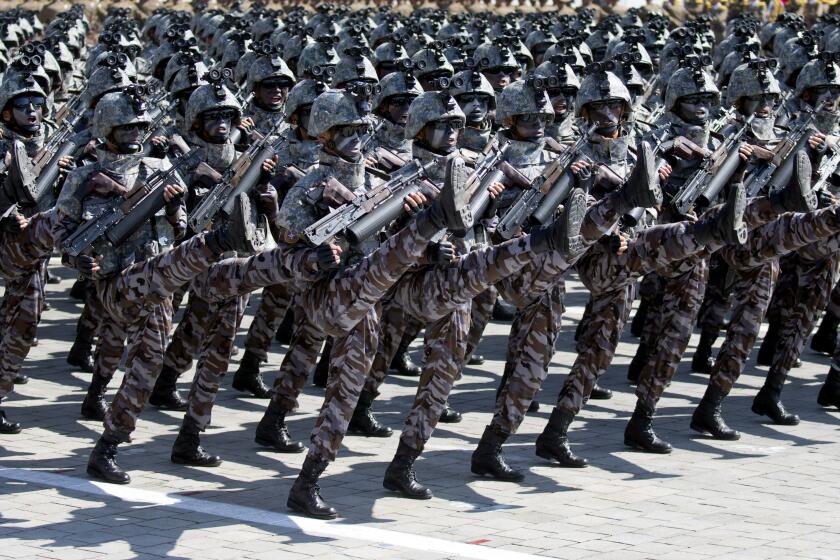Rain, High Winds Forecast for Thursday Liftoff : Weather Threatens Shuttle Launch
KENNEDY SPACE CENTER, Fla. — NASA pressed ahead Tuesday with the countdown to launch the space shuttle Atlantis on a secret military mission, but Florida’s fickle weather put the liftoff in doubt.
The countdown, which began at midnight Sunday, was moving toward an expected blastoff between 3:32 a.m. and 6:32 a.m. PST Thursday, but the forecast for Thursday morning called for rain showers and unacceptably high winds, National Aeronautics and Space Administration officials said. A final decision will not be made until much closer to launch time, officials said.
The flight, the second since the Challenger disaster of 1986, reportedly will take aloft an advanced Air Force spy satellite capable of monitoring Soviet missile and troop movements at night and in all weather. But details of the payload, flight path and schedule are being kept secret to prevent the Soviets from tracking the ship, calculating its orbit and taking measures to thwart its reconnaissance mission.
Landing to Remain Classified
Atlantis and its five-man military crew are scheduled to return to Edwards Air Force Base in California about four days after launch, but the landing date and time will remain classified until 24 hours beforehand.
The flight represents the second step in America’s return to manned spaceflight after the devastating Challenger explosion of January, 1986, that took the lives of six astronauts and a New Hampshire schoolteacher.
After the accident, the shuttle hardware and the NASA bureaucracy underwent a painstaking 32-month review. NASA made hundreds of changes in the spacecraft design, replaced dozens of top officials and vowed to make a new commitment to safety in spaceflight.
The shuttle resumed flying Sept. 29, when the spaceship Discovery lifted off on a flawless four-day mission that served chiefly as a shakedown cruise for the redesigned shuttle.
The military flight set for launch Thursday morning from Cape Canaveral’s pad 39-B will test the shuttle further, reportedly requiring the use of the cargo bay’s robot arm to deploy the $500-million spy satellite.
Space Walk May Be Included
Although NASA and Air Force officials will not confirm it, civilian space experts say the flight also will probably include a space walk by one of the astronauts to check that the satellite’s broad solar panels have unfolded properly.
At the controls will be veteran shuttle skipper Robert L. (Hoot) Gibson, 42, a Navy commander, and co-pilot Guy S. Gardner, 40, an Air Force colonel making his first flight. The other crew members are Air Force Col. Richard M. (Mike) Mullane, 43; Air Force Lt. Col. Jerry L. Ross, 40, and Navy Cmdr. William M. Shepherd, 39.
“We believe we’re ready to go,” Gibson said shortly after arriving with his crew at Cape Canaveral Monday from their base at Johnson Space Center in Houston. “We’re looking forward very eagerly to getting back into space again.”
On Tuesday, Gibson and Gardner practiced landing procedures in Air Force T-38 jet trainers.
Thursday’s flight will be the third classified military mission for the shuttle. The previous flights were in January and October, 1985, when the reusable spacecraft lofted what were reported to be a “Magnum” electronic intelligence satellite and two communications craft.
Will Send Back Images
Civilian space analysts and reliable trade journals say the satellite set for launch this week is a “Lacrosse” imaging radar that can peer down on 80% of the Soviet Union from low-altitude orbit and photograph objects on the ground through darkness, clouds, fog or even dense foliage. It will send back detailed, digitized images that will be converted to still photographs and moving pictures at U.S. intelligence facilities.
If it is a Lacrosse, said John Pike, chief space expert for the Federation of American Scientists, it is one of the latest generation of “24-hour, all-weather satellites for strategic and tactical targeting in the Soviet Union and Eastern Europe, as well as arms control verification.”
Pike said one of the spy craft’s primary missions would be to guide the new stealth B-2 bomber to Soviet ballistic missiles mounted on trucks and rail cars. The satellite also will be capable of finding tanks and airfields in Warsaw Pact nations for targeting by U.S. strike jets.
Another of the satellite’s missions will be to verify that the Soviets are complying with the recently signed intermediate-range nuclear forces (INF) treaty by removing medium-range missiles in Europe. It also will play a role in assuring compliance with future agreements limiting long-range missiles.
The satellite will be one of a constellation of four Lacrosse satellites that can be serviced by shuttle-borne astronauts, Pike said.
Failure of Rockets
The spy craft is one of two dozen sitting on the ground waiting for a lift into space, Air Force officials said. The military satellite program is slowly returning to business after a 2 1/2-year delay caused by the Challenger accident and back-to-back failures of unmanned Air Force rockets.
More to Read
Sign up for Essential California
The most important California stories and recommendations in your inbox every morning.
You may occasionally receive promotional content from the Los Angeles Times.









